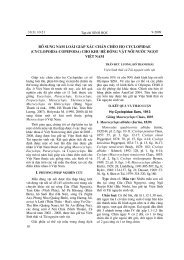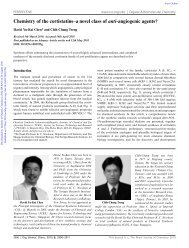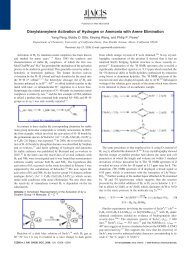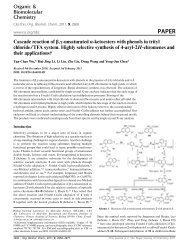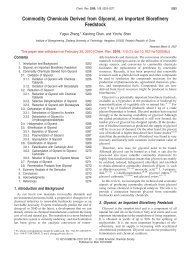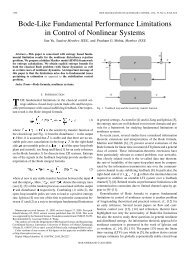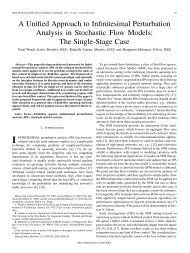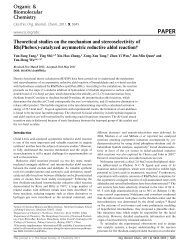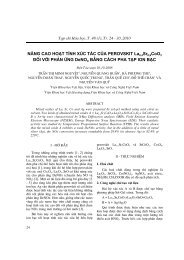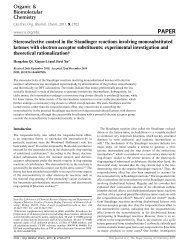PAPER Effect of surfactants on the chemiluminescence of acridinium ...
PAPER Effect of surfactants on the chemiluminescence of acridinium ...
PAPER Effect of surfactants on the chemiluminescence of acridinium ...
Create successful ePaper yourself
Turn your PDF publications into a flip-book with our unique Google optimized e-Paper software.
(d) Compound 1b. A soluti<strong>on</strong> <str<strong>on</strong>g>of</str<strong>on</strong>g> 2¢,6¢-dimethyl-4¢carboxylphenyl<br />
N-sulfopropyl<strong>acridinium</strong>-9-carboxylate 2,5<br />
(30 mg, 0.061 mmole) in DMF (3 mL) was treated with diisopropylethylamine<br />
(0.016 mL, 0.0917 mmole, 1.5 equivalents)<br />
and N,N,N¢,N¢-tetramethyl-O-(N-succinimidyl)ur<strong>on</strong>ium tetrafluoroborate<br />
(TSTU) (22 mg, 0.0732 mmol, 1.2 equivalents). The<br />
reacti<strong>on</strong> was stirred at room temperature. After 15 min, HPLC<br />
analysis <str<strong>on</strong>g>of</str<strong>on</strong>g> a small porti<strong>on</strong> <str<strong>on</strong>g>of</str<strong>on</strong>g> <strong>the</strong> reacti<strong>on</strong> mixture was performed<br />
using a Phenomenex, 10 micr<strong>on</strong>, C 18 3.9 mm ¥ 25 cm column and<br />
a 30 min gradient <str<strong>on</strong>g>of</str<strong>on</strong>g> 10 → 70% B (A = water with 0.05% TFA,<br />
B = MeCN with 0.05% TFA) at a flow rate <str<strong>on</strong>g>of</str<strong>on</strong>g> 1.0 mL min -1 and<br />
UV detecti<strong>on</strong> at 260 nm. Product NHS ester (compound v) was<br />
observed eluting at 20 min and was <strong>the</strong> major comp<strong>on</strong>ent. This<br />
DMF soluti<strong>on</strong> <str<strong>on</strong>g>of</str<strong>on</strong>g> <strong>the</strong> NHS ester, compound v, was added dropwise<br />
to a soluti<strong>on</strong> <str<strong>on</strong>g>of</str<strong>on</strong>g> N,N-bis(3-aminopropyl)methylamm<strong>on</strong>ium-1,3propane<br />
sulf<strong>on</strong>ate, compound iv, (0.136 g, 0.0304 mmol, 5<br />
equivalents, HBr salt) dissolved in DMF (1 mL) and 0.25 M<br />
sodium bicarb<strong>on</strong>ate (1 mL). The reacti<strong>on</strong> was stirred at room<br />
temperature. After 3 h, HPLC analysis showed clean c<strong>on</strong>versi<strong>on</strong><br />
to <strong>the</strong> product 1b, eluting at 12.4 min. Using a 40 min gradient <str<strong>on</strong>g>of</str<strong>on</strong>g><br />
10 → 40% B (A = water with 0.05% TFA, B = MeCN with 0.05%<br />
TFA), <strong>the</strong> product eluted at 19.2 min. The product was purified<br />
by preparative HPLC using a YMC, 10 micr<strong>on</strong>, C 18 30 ¥ 250 mm<br />
column and 40 min gradient <str<strong>on</strong>g>of</str<strong>on</strong>g> 10 → 40% B (A = water with<br />
0.05% TFA, B = MeCN with 0.05% TFA) at a solvent flow rate <str<strong>on</strong>g>of</str<strong>on</strong>g><br />
20 mL min -1 and UV detecti<strong>on</strong> at 260 nm. The HPLC fracti<strong>on</strong>s<br />
c<strong>on</strong>taining product 1b were combined and c<strong>on</strong>centrated under<br />
reduced pressure to yield a yellow, sticky solid. Yield = 45 mg<br />
(86%, TFA salt); d H (500 MHz, CF 3COOD) 2.40 (br s, 2 H), 2.56<br />
(br s, 10 H), 2.95 (br s, 2 H), 3.24 (s, 3 H), 3.46 (br t, 4 H), 3.65<br />
(br s, 4 H), 3.72–3.86 (br m, 6 H), 5.87 (br t, 2 H), 7.71 (s, 2 H),<br />
8.15 (t, 2 H), 8.57 (t, 2 H), 8.76 (d, 2 H, J = 8.6), 8.92 (d, 2 H, J =<br />
9.1); d C (125 MHz, CF 3COOD) 16.3, 17.7, 20.2, 22.2, 23.2, 37.4,<br />
37.8, 47.4, 48.1, 48.2, 50.0, 59.1, 60.1, 60.9, 118.3, 123.4, 124.9,<br />
127.9, 128.4, 129.5, 130.6, 131.9, 140.5, 141.5, 148.8, 151.5, 171.8;<br />
MALDI-TOF MS m/z 743.2 (M + H) + ;HRMSm/z 743.2786<br />
(M + H) + (743.2784 calculated).<br />
(e) Compound 3b. A soluti<strong>on</strong> <str<strong>on</strong>g>of</str<strong>on</strong>g> compound 1b (45 mg,<br />
0.0525 mmol) in methanol (3.6 mL) and water (0.4 mL) was<br />
treated with diisopropylethylamine (0.053 mL, 0.303 mmol, 5.8<br />
equivalents) and glutaric anhydride (34.5 mg, 0.303 mmol, 5.8<br />
equivalents). The reacti<strong>on</strong> was stirred at room temperature. After<br />
15 min, HPLC analysis <str<strong>on</strong>g>of</str<strong>on</strong>g> a small porti<strong>on</strong> <str<strong>on</strong>g>of</str<strong>on</strong>g> <strong>the</strong> reacti<strong>on</strong> mixture<br />
was performed using a Phenomenex, 10 micr<strong>on</strong>, C 18 3.9 mm ¥<br />
25 cm column and a 30 min gradient <str<strong>on</strong>g>of</str<strong>on</strong>g> 10 → 70% B (A = water<br />
with 0.05% TFA, B = MeCN with 0.05% TFA) at a flow rate <str<strong>on</strong>g>of</str<strong>on</strong>g><br />
1.0 mL min -1 and UV detecti<strong>on</strong> at 260 nm. The glutarate derivative<br />
was observed eluting at 14 min and was <strong>the</strong> major comp<strong>on</strong>ent. The<br />
solvent was <strong>the</strong>n removed under reduced pressure. The residue<br />
was dissolved in DMF (3.6 mL) and water (0.4 mL). This soluti<strong>on</strong><br />
was treated with diisopropylethylamine (0.106 mL, 10 equivalents)<br />
and TSTU (182 mg, 10 equivalents). The reacti<strong>on</strong> was stirred at<br />
room temperature. After 10 min, HPLC analysis showed complete<br />
c<strong>on</strong>versi<strong>on</strong> to <strong>the</strong> product 3b eluting at 15.3 min. The product was<br />
purified by preparative HPLC using a YMC, 10 micr<strong>on</strong>, C 18 30 ¥<br />
250 mm column and 40 min gradient <str<strong>on</strong>g>of</str<strong>on</strong>g> 10 → 40% B (A = water<br />
with 0.05% TFA, B = MeCN with 0.05% TFA) at a solvent flow<br />
rate <str<strong>on</strong>g>of</str<strong>on</strong>g> 20 mL min -1 and UV detecti<strong>on</strong> at 260 nm. The HPLC<br />
fracti<strong>on</strong>s c<strong>on</strong>taining product 3b were combined, frozen at -80 ◦ C<br />
and lyophilized to dryness to a yellow, fluffy powder. Yield =<br />
28.7 mg (50%); d H (500 MHz, CF 3COOD) 2.27 (br m, 4 H), 2.44<br />
(brs,2H),2.62(s,8H),2.71(brs,2H),2.87(brs,2H),3.03<br />
(br s, 2 H), 3.13 (s, 4 H), 3.26 (s, 3 H), 3.50 (br s, 2 H), 3.64 (m,<br />
6 H), 3.83 (br s, 4 H), 3.91 (br s, 2 H), 5.94 (br t, 2 H), 7.78 (s, 2<br />
H), 8.21 (t, 2 H), 8.63 (t, 2 H), 8.82 (d, 2 H, J = 8.6), 9.00 (d, 2<br />
H, J = 8.9); d C (125 MHz, CF 3COOD) 16.3, 17.7, 19.8, 20.1, 22.1,<br />
23.1, 24.5, 24.9, 29.1, 31.9, 33.8, 37.4, 47.5, 48.2, 50.1, 60.0, 60.2,<br />
118.3, 123.4, 124.9, 127.9, 128.5, 129.4, 130.6, 131.9, 140.4, 141.5,<br />
148.7, 151.5, 168.8, 173.9, 176.7, 177.5, 180.2; MALDI-TOF MS<br />
m/z 955.2 (M + H) + ;HRMSm/z 954.3274 (M + H) + (954.3265<br />
calculated).<br />
(f) Theophylline c<strong>on</strong>jugate 2b. A soluti<strong>on</strong> <str<strong>on</strong>g>of</str<strong>on</strong>g> compound<br />
1b (22 mg, 0.0257 mmol, TFA salt) in DMSO<br />
(2 mL) was added to 8-carboxypropyl<strong>the</strong>ophylline (5.5 mg,<br />
0.0207 mmol, Sigma) followed by diisopropylethylamine<br />
(0.0088 mL, 0.0505 mmol, 2 equivalents) and (benzotriazol-<br />
1-yl-oxy)tris(dimethylamino)phosph<strong>on</strong>ium hexafluorophosphate<br />
(BOP) (13.7 mg, 0.031 mmol, 1.2 equivalents). The reacti<strong>on</strong> was<br />
stirred at room temperature for 16 h and <strong>the</strong>n analyzed by HPLC<br />
using a Phenomenex, 10 micr<strong>on</strong>, C 18 3.9 mm ¥ 25 cm column<br />
and a 40 min gradient <str<strong>on</strong>g>of</str<strong>on</strong>g> 10 → 40% B (A = water with 0.05%<br />
TFA, B = MeCN with 0.05% TFA) at a flow rate <str<strong>on</strong>g>of</str<strong>on</strong>g> 1.0 mL min -1<br />
and UV detecti<strong>on</strong> at 260 nm. Product was observed eluting at<br />
23.6 min and was <strong>the</strong> major comp<strong>on</strong>ent. The product was purified<br />
by preparative HPLC using a YMC, 10 micr<strong>on</strong>, C 18 30 ¥ 250 mm<br />
column and 40 min gradient <str<strong>on</strong>g>of</str<strong>on</strong>g> 10 → 40% B (A = water with<br />
0.05% TFA, B = MeCN with 0.05% TFA) at a solvent flow<br />
rate <str<strong>on</strong>g>of</str<strong>on</strong>g> 20 mL min -1 and UV detecti<strong>on</strong> at 260 nm. The HPLC<br />
fracti<strong>on</strong>s c<strong>on</strong>taining product 2b were combined, frozen at -80 ◦ C<br />
and lyophilized to dryness to a yellow, fluffy powder. Yield = 7.5 mg<br />
(37%); d H (500 MHz, CF 3COOD) 2.36 (br s, 2 H), 2.50 (br s, 4 H),<br />
2.62 (br s, 2 H), 2.67 (s, 6 H), 2.79 (br s, 2 H), 3.06 (m, 2 H), 3.30<br />
(s, 3 H), 3.46 (t, 2 H, J = 7.8), 3.51 (t, 2 H, J = 7.2), 3.65 (br s, 4<br />
H), 3.70 (s, 3 H), 3.81–3.89 (m, 4 H), 3.91 (s, 3 H), 3.94 (t, 2 H, J =<br />
6.4), 5.99 (m, 2 H), 7.82 (s, 2 H), 8.25 (t, 2 H), 8.67 (t, 2 H), 8.87 (d,<br />
2H,J = 8.6), 9.04 (d, 2 H, J = 9.5); MALDI-TOF MS m/z 992.0<br />
(M + H) + ;HRMSm/z 991.3680 (M + H) + (991.3694 calculated).<br />
General procedure for protein labeling with <strong>acridinium</strong> esters<br />
Three proteins were used for labeling with <strong>the</strong> <strong>acridinium</strong> ester<br />
labels 3a and 3b; a murine anti-TSH m<strong>on</strong>ocl<strong>on</strong>al antibody with<br />
an acidic pI = 5.6 (TSH = Thyroid Stimulating Horm<strong>on</strong>e), a murine<br />
anti-HBsAg m<strong>on</strong>ocl<strong>on</strong>al antibody with a neutral pI = 7 (HBsAg =<br />
Hepatitis B Surface Antigen) and egg white avidin, pI = 10.5. The<br />
following is a typical procedure for labeling <strong>the</strong> three proteins with<br />
10 equivalents input <str<strong>on</strong>g>of</str<strong>on</strong>g> <strong>acridinium</strong> ester label.<br />
The anti-TSH murine m<strong>on</strong>ocl<strong>on</strong>al antibody (1 mg, 6.67<br />
nanomoles, stock soluti<strong>on</strong> 5 mg mL -1 , 0.2 mL) was diluted with<br />
0.2 mL <str<strong>on</strong>g>of</str<strong>on</strong>g> 0.1 M sodium carb<strong>on</strong>ate, pH 9. The protein soluti<strong>on</strong><br />
was treated with DMSO soluti<strong>on</strong>s <str<strong>on</strong>g>of</str<strong>on</strong>g> <strong>acridinium</strong> esters as follows:<br />
for labeling with 10 equivalents <str<strong>on</strong>g>of</str<strong>on</strong>g> 3a, 0.0129 mL <str<strong>on</strong>g>of</str<strong>on</strong>g> a 5 mg mL -1<br />
DMSO soluti<strong>on</strong> <str<strong>on</strong>g>of</str<strong>on</strong>g> <strong>the</strong> compound was added and, for labeling<br />
with 10 equivalents <str<strong>on</strong>g>of</str<strong>on</strong>g> compound 3b, 0.0127 mL <str<strong>on</strong>g>of</str<strong>on</strong>g> a 5 mg mL -1<br />
DMF soluti<strong>on</strong> was added. The labeling reacti<strong>on</strong>s were stirred at<br />
4 ◦ C for 16 h and were <strong>the</strong>n transferred to 4 mL Amic<strong>on</strong> TM filters<br />
(MW 30 000 cut<str<strong>on</strong>g>of</str<strong>on</strong>g>f) and diluted with 3.5 mL de-i<strong>on</strong>ized water.<br />
This journal is © The Royal Society <str<strong>on</strong>g>of</str<strong>on</strong>g> Chemistry 2011 Org. Biomol. Chem., 2011, 9, 5092–5103 | 5101



